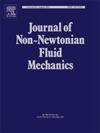Atomizing high-viscosity non-Newtonian fluids with the ACLR nozzle: Correlation between internal flow and external spray instabilities
IF 2.7
2区 工程技术
Q2 MECHANICS
引用次数: 0
Abstract
Spray drying is a widely used method for producing food powders in large quantities, but it also has a high energy demand. To address this, one can increase the solid content of liquid feeds, although this, in turn, poses the challenge of atomizing high-viscosity liquids into fine droplets. The Air-Core-Liquid-Ring (ACLR) nozzle offers a potential solution for the atomization by inducing air and creating an annular flow inside the nozzle. Nevertheless, a challenge of this design is that it tends to present internal instabilities. This study investigates how feed viscosities up to 3 Pa·s, and feed dry-matter contents up to 57 % wt., influence the internal flow conditions and the resulting spray performance, i.e., the droplet size distribution and the spray angle. The results show that, while internal instabilities increment with increasing viscosities, the ACLR can seemingly achieve atomization with viscosities as high as 3 Pa·s, even at, compared to pressure swirl nozzles, low pressures (7 bar) and low air-to-liquid mass ratios (0.8). Nonetheless, a fraction of droplets over 500 µm remains, which needs to be addressed through higher ALRs or a geometrical optimization of the nozzle, before the nozzle can be considered for industrial applications. Additionally, we showed that the internal flow and the external spray instabilities can be correlated with each other. This confirms that any future studies attempting to increase the spray stability of the ACLR nozzle can focus on only one of these factors, and reasonably expect that the others will also improve.

用ACLR喷嘴雾化高粘度非牛顿流体:内部流动与外部喷雾不稳定性之间的关系
喷雾干燥是一种广泛使用的大批量生产食品粉末的方法,但它也具有较高的能量需求。为了解决这个问题,可以增加液体进料的固体含量,尽管这反过来又提出了将高粘度液体雾化成细液滴的挑战。air - core - liquid - ring (ACLR)喷嘴为雾化提供了一种潜在的解决方案,通过在喷嘴内诱导空气并形成环形流。然而,这种设计的一个挑战是,它往往呈现内部不稳定。本研究考察了高达3pa·s的进料粘度和高达57% wt.的进料干物质含量如何影响内部流动条件和由此产生的喷雾性能,即液滴大小分布和喷雾角度。结果表明,虽然内部不稳定性随着粘度的增加而增加,但与压力旋流喷嘴相比,即使在低压(7 bar)和低气液质量比(0.8)下,ACLR似乎也能实现高达3 Pa·s的雾化。尽管如此,仍有一部分超过500µm的液滴残留,这需要通过更高的alr或喷嘴的几何优化来解决,然后才能考虑将喷嘴用于工业应用。此外,我们还证明了内部流动和外部喷雾不稳定性可以相互关联。这证实了任何试图提高ACLR喷嘴喷雾稳定性的未来研究都只能关注这些因素中的一个,并且合理地期望其他因素也会得到改善。
本文章由计算机程序翻译,如有差异,请以英文原文为准。
求助全文
约1分钟内获得全文
求助全文
来源期刊
CiteScore
5.00
自引率
19.40%
发文量
109
审稿时长
61 days
期刊介绍:
The Journal of Non-Newtonian Fluid Mechanics publishes research on flowing soft matter systems. Submissions in all areas of flowing complex fluids are welcomed, including polymer melts and solutions, suspensions, colloids, surfactant solutions, biological fluids, gels, liquid crystals and granular materials. Flow problems relevant to microfluidics, lab-on-a-chip, nanofluidics, biological flows, geophysical flows, industrial processes and other applications are of interest.
Subjects considered suitable for the journal include the following (not necessarily in order of importance):
Theoretical, computational and experimental studies of naturally or technologically relevant flow problems where the non-Newtonian nature of the fluid is important in determining the character of the flow. We seek in particular studies that lend mechanistic insight into flow behavior in complex fluids or highlight flow phenomena unique to complex fluids. Examples include
Instabilities, unsteady and turbulent or chaotic flow characteristics in non-Newtonian fluids,
Multiphase flows involving complex fluids,
Problems involving transport phenomena such as heat and mass transfer and mixing, to the extent that the non-Newtonian flow behavior is central to the transport phenomena,
Novel flow situations that suggest the need for further theoretical study,
Practical situations of flow that are in need of systematic theoretical and experimental research. Such issues and developments commonly arise, for example, in the polymer processing, petroleum, pharmaceutical, biomedical and consumer product industries.

 求助内容:
求助内容: 应助结果提醒方式:
应助结果提醒方式:


